by Corry Shores
[Search Blog Here. Index-tags are found on the bottom of the left column.]
[Central Entry Directory]
[Other entries in the Merleau-Ponty phenomenology series.]
[Note: all boldfaces in quotations are my own modifications. Quoted citations come from PDF translations on the internet (see works cited). Page citations give PDF number, then 'see ...' for the printed text page citation.]
Breath of Color:
Merleau-Ponty on Painting and Cézanne
in Eye and Mind
and Cézanne's Doubt
in Eye and Mind
and Cézanne's Doubt

(Thanks awesome-art.com)
What does the phenomenology of painting go to do with you?
Painters are sensitive to the way things appear to us. But what if things appeared to us because we were completely meshed with the world, rather than it be the case that we stand before the world and the objects around us stand over against us? Then the painter could tell us more about how we are inherently mixed-in with the world we perceive.
Brief Summary
Our senses integrate us with a world that is integrated within itself. Painters like Cézanne have insights into how this integration works.
Points relative to Deleuze:
Deleuze also thinks that painters can teach us about phenomena. However, Deleuze thinks we learn much different lessons. Painters show us that our contact with the world is not one of integration, but of us facing a world of difference that is itself different from us. [See this entry for more.]
Merleau-Ponty:
From Eye and Mind
Our bodies are integrated into the fabric of the world and into what gives it meaning [see this entry on horizonal integration as meaning, from Phenomenology of Perception]. Painters are able to live purely in this enmeshment with the world and express it visually in their works. This is their 'secret science' (Merleau-Ponty, Eye and Mind, 2c, see 161d).
We first note how our vision and movement in the world indicates our integration with it. We move about the world by means of our vision. Because we see the world, we can interact with it, relate to it, move around through it. (see 162b.c)
Now, we are not just able to sense the things in the world around us. We can also sense our selves. But there is more. We can notice that we are seeing something. In other words, we can see our selves seeing. (see 162d)
So we move through the world in an integrated way with it. The fact that we are moving around it tells us we are somehow apart from it, but the fact we are always integrated indicates that we are also somehow a part of it. [See this entry from the Phenomenology of Perception for more on our integration with the world. There is the famous example of the walking stick. A stick from a tree might seem like a part of the world that is not a part of us. But when a blind person learns to walk with a stick, she soon begins to be able to actually feel the world with the stick, as if her nerve endings extended through the wood to the farthest side that does the feeling. So in a way, parts the world are parts of us.] [And also note the sympathy our sense organs have with the world. Parts of our ears for example vibrate at the same frequency of the sound wave they are receiving. So we profoundly get in touch with the world around us, and it becomes ambiguous who is the sensor and who is the sensed.]
Visible and mobile, my body is a thing among things; it is one of them. It is caught in the fabric of the world, and its cohesion is that of a thing. But because it moves itself and sees, it holds things in a circle around itself. Things are an annex or prolongation of itself; they are incrusted in its flesh, they are part of its full definition; the world is made of the very stuff of the body. (3c, see 163b)We in a way are integrated with the things around us by means of our vision. Our body has a certain affinity for them which allows us to see them. They have a sort of 'secret visibility' within us. Painting is faced with the task of depicting this inner secret visibility of the external world, based on our bodily affinity and integration with it.
The body's animation is not the assemblage or juxtaposition of its parts. Nor is it a question of a mind or spirit coming down from somewhere else into an automation— which would still imply that the body itself is without an inside and without a "self." A human body is present when, between the see-er and the visible, between touching and touched, between one eye and the other, between hand and hand a kind of crossover occurs. (4a, see 163d)
Our organs are not instruments; on the contrary, our instruments are added-on organs. Space is not what it was in the Dioptrics, a network of relations between objects such as would be seen by a third party, witnessing my vision, or by a geometer looking over it and reconstructing it from outside. It is, rather, a space reckoned starting from me as the null point or degree zero of spatiality. I do not see it according to its exterior envelope; I live it from the inside; I am immersed in it. (12c, see 178ab)
Once this strange system of exchanges is given, we find before us all the problems of painting. These problems illustrate the enigma of the body, which enigma in turn legitimates them. Since things and my body are made of the same stuff, vision must somehow come about in them; or yet again, their manifest visibility must be repeated in the body by a secret visibility. "Nature is on the inside," says Cézanne. Quality, light, color, depth, which are there before us, are there only because they awaken an echo in our bodies and because the body welcomes them. (4a, see 164a)When we see things, we take them into us, in a sense. And painters must be very sensitive to how our vision takes in the world. We might even say that it is a matter of letting the world see us, that is, to penetrate us the way our gaze penetrates it. It is like our inhalations are the worlds exhalations [we discussed this metaphor in this entry from Phenomenology of Sensation].
We speak of "inspiration," and the word should be taken literally. There really is inspiration and expiration of Being, respiration in Being, action and passion so slightly discernible that it becomes impossible to distinguish between who sees and who is seen, who paints and what is painted. We say that a human being is born the moment when something that was only virtually visible within the mother's body becomes at once visible for us and for itself. The painter's vision is an ongoing birth. (6c, see 167d)Mirrors help us see the "metaphysical structure" of our our entwinement with the world. We see an image of ourself. We also sympathize with it. It is as if we doubly feel what we are feeling and what the image is feeling. And the image of us will be seen by others. They too might sympathize with what they see. In this way it is as if we and the world share the same flesh. (see 168a.c)
Let's also note how when we see something, we see a world that is integrated with itself. He offers two excellent examples. The first is Rembrandt's Nightwatch.
The hand pointing toward us in The Nightwatch is truly there only when we see that its shadow on the captain's body presents it simultaneously in profile. The spatiality of the captain lies at the intersection of the two perspectives which are incompossible and yet together. (6a, see 167a)We might use this example to illustrate another point he made in Phenomenology of Perception about the integration of the parts of the world, how to see the front of an object is also to have on the horizon of our awareness the way that things behind it would be seeing the back side. The Nightwatch example also shows us how when we see something from one perceptive, we see it from all the others, because the way it looks from all the other perspectives influences the way we see it from our own point of view.
We see the shadow of the pointing-man's hand cast upon the captain's body. On the one hand, we see what his hand looks like from the front.
Rembrandt. De Nachtwacht (The Night Watch), detail
So far, we might regard the images before us two-dimensionally. However, the shadow shows us the profile of the arm, as if we were at the same time viewing it from the side.
So we also see how his hand looks from objects standing to his right, all while we look at him from the front. The parts of our world are all coherently interwoven. Another great example is seeing the bottom of a pool. We might think that we are seeing the bottom, even though the water is obscuring it. But in fact, the water is the very reason we can see it. The water is what is letting the light waves through. And when we look to the trees above the pool, we see a reflection of the ripples. The tree has it appearance only because it is integrated with the water motion.
When through the water's thickness I see the tiled bottom of the pool, I do not see it despite the water and the reflections; I see it through them and because of them. If there were no distortions, no ripples of sunlight, if it were without that flesh that I saw the geometry of the tiles, then I would cease to see it as it is and where it is—which is to say, beyond any identical, specific place. I cannot say that the water itself—the aqueous power, the syrupy and shimmering element—is in space; all this is not somewhere else either, but it is not in the pool. It inhabits it, is materialized there, yet it is not contained there; and if I lift my eyes toward the screen of cypresses where the web of reflections plays, I must recognize that the water visits it as well, or at least sends out to it its active, living essence. This inner animation, this radiation of the visible, is what the painter seeks beneath, the words depth, space, and color. (13-14; see 182a.b)There is something else we noted before in Phenomenology of Perception. Each sense senses things differently. But what they sense is always analogous between the different senses. Our vision has a sense of space. So too does our vision. They are not the same, but the two mesh together in one act of space-perception. Merleau-Ponty in Eye and Mind says something similar. He notes how painters also make good sculptures, for example. This is because what we gain in knowledge of sight translates into knowledge of analogous things in the other senses.
Anyone who thinks about the matter finds it astonishing that very often a good painter can also produce good drawings or good sculpture. Since neither the means of expression nor the creative gestures are comparable, this is proof that there is a system of equivalences, a Logos of lines, of lighting, of colors, of reliefs, of masses—a nonconceptual presentation of universal Being. (15b; see 182c)So our vision allows us to see things from all perspectives, or at least to have all these other perspectives on the horizon of our awareness. He has us also consider when we look straight down a set of train tracks. They converge on the horizon. But it is only because they converge that we know they remained parallel even at the furthest extent we see. In a way, we are indirectly seeing their being parallel down there by viewing them as convergent from here. So in a sense, when we see the train tracks, we see also something invisible from our perspective, which is their remaining parallel throughout. An invisible absence is given in the visual presence. But we might say there is another sort of invisibility that is given to us. That would be our entwinement with the world, our already being a part of it and enmeshed with it as one flesh.
We must take literally what vision teaches us: namely, that through it we touch the sun and the stars, that we are everywhere at once, and that even our power to imagine ourselves elsewhere—"I am in Petersburg in my bed, in Paris, my eyes see the sun"—or freely to envision real beings, wherever they are, borrows from vision and employs means we owe to it. Vision alone teaches us that beings that are different, "exterior," foreign to one another, are yet absolutely together, are "simultaneity"; which is a mystery psychologists handle the way a child handles explosives. Robert Delaunay says succinctly, "The railroad track is the image of succession which comes closest to the parallel: the parity of the rails." The rails converge and do not converge; they converge in order to remain equidistant farther away. The world is in accordance with my perspective in order to be independent of me, is for me in order to be without me, to be a world. The "visual quale" gives me, and is alone in doing so, the presence of what is not me, of what is simply and fully. It does so because, as a texture, it is the concretion of a universal visibility, of one sole Space that separates and reunites, that sustains every cohesion (and even that of past and future, since there would be no such cohesion if they were not essentially parts of the same space). Every visual something, as individual as it is, functions also as a dimension, because it is given as the result of a dehiscence of Being. What this ultimately means is that the hallmark of the visible is to have a lining of invisibility in the strict sense, which it makes present as a certain absence. (17-18b; see 187a.c)
There is that which reaches the eye head on, the frontal properties of the visible; but there is also that which reaches it from below—the profound postural latency whereby the body raises itself to see—and that which reaches vision from above like the phenomena of flight, of swimming, of movement, where it participates no longer in the heaviness of origins but in free | accomplishments. Through vision, then, the painter touches both extremities. In the immemorial depth of the visible, something has moved, caught fire, which engulfs his body; everything he paints is in answer to this incitement, and his hand is "nothing but the instrument of a distant will." Vision is the meeting, as at a crossroads, of all the aspects of Being. "A certain fire wills to live; it wakes. Working its way along the hand's conductor, it reaches the canvas and invades it; then, a leaping spark, it arcs the gap in the circle it was to trace: the return to the eye, and beyond." There is no break at all in this circuit; it is impossible to say that here nature ends and the human being or expression begins. It is, then, silent Being that itself comes to show forth its own meaning. (18c, see 187-188)
Merleau-Ponty:
Cézanne's Doubt
Cézanne's Doubt
According to Merleau-Ponty, Cézanne painted things in a distorted way, but this is because he knew how our minds would reconfigure them to have the effect of seeming normal. When we look at something, it is not as though our eyes are photo cameras. Our eyes are constantly shifting. And contextual factors alter the way things look [see this entry for the example of the moon on the horizon.] In a sense, Cézanne paints what we really see and not just what we would see if our eyes were cameras.
This is the reason for his difficulties and for the distortions one finds in his pictures between 1870 and 1890. Cups and saucers on a table seen from the side should be elliptical, but Cezanne paints the two ends of the ellipse swollen and expanded. The work table in his portrait of Gustave Geffroy stretches, contrary to the laws of perspective, into the lower part of picture. In giving up the outline Cezanne was abandoning himself to chaos of sensation, which would upset the objects and constantly suggest illusions, as, for example, the illusion we have when we move our heads that objects themselves are moving—if our judgment did not constantly set these appearances straight. (2; see 13a)
Cezanne did not think he had to choose between feeling and thought, as if he were deciding between chaos and order. He did not want to separate the stable things which we see and the shifting way in which they appear. He wanted to depict matter as it takes on form, the birth of order through spontaneous organization. He makes a basic distinction not between "the senses" and "the understanding" but rather between the spontaneous organization of the things we perceive and the human organization of ideas and sciences. We see things; we agree about them; we are anchored in them; and it is with "nature" as our base that we construct our sciences. Cezanne wanted to paint this primordial world, and his pictures therefore seem to show nature pure, while photographs of the same landscapes suggest man's works, conveniences, and imminent presence. (4a, see 13c.14a)
By remaining faithful to the phenomena in his investigations of perspective, Cezanne discovered what recent psychologists have come to formulate: the lived perspective, that which we actually perceive, is not a geometric or photographic one. The objects we see close at hand appear smaller, those far away seem larger than they do in a photograph. (This is evident in films: an approaching train gets bigger much faster than a real train would under the same circumstances.) To say that a circle seen obliquely is seen as an ellipse is to substitute for our actual perception what we would see if we were cameras: in reality we see a form which oscillates around the ellipse without being an ellipse. In a portrait of Mme Cezanne, the border of the wallpaper on one side of her body does not form a straight line with that on the other: and indeed it is known that if a line passes beneath a wide strip of paper, the two visible segments appear dislocated. Gustave Geffroy's table stretches into the bottom of the picture, and indeed, when our eye runs over a large surface, the images it successively receives are taken from different points of view, and the whole surface is warped. It is true that I freeze these distortions in repainting them on the canvas; I stop the spontaneous movement in which they pile up in perception and tend toward the geometric perspective. (4b, see 14a.c)
Similarly, it is Cezanne's genius that when the overall composition of the picture is seen globally, perspectival distortions are no longer visible in their own right but rather contribute, as they do in natural vision, to impression of an emerging order, an object in the act of appearing, organizing itself before our eyes. In the same way, the contour of an object conceived as a line encircling the object belongs not to the visible we but to geometry. If one outlines the shape of an apple with a continuous line, one makes an object of the shape, whereas the contour is rather ideal limit toward which the sides of the apple recede in depth. Not to indicate any shape would be to deprive the objects of their identity. To trace just a single outline sacrifices depth—that is, the dimension in which the thing is presented not as spread out before us but as an inexhaustible reality full of reserves. That is why Cezanne follows the swell of the object in modulated colors and indicates several outlines in blue. Rebounding among these, one's glance captures a shape that emerges from among them all, just as it does in perception. (4d, see 14-15)
the world is a mass without gaps, a system of colors across which the receding perspective, the outlines, angles, and curves are inscribed like lines of force; the spatial structure vibrates as it is formed. (5a, see 15b)
Cézanne: Still Life with Apples (1890-94)
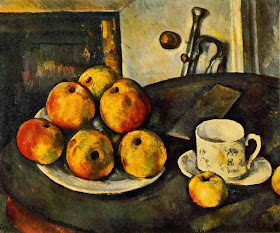
(Thanks dl.ket.org)

(Thanks dl.ket.org)
Cézanne. Still Life, Fruit and Pitcher on Table

(Thanks awesome-art.com)

(Thanks awesome-art.com)
Cézanne: Portrait of a Woman in Green Hat (Mme Cézanne) (1894-95)
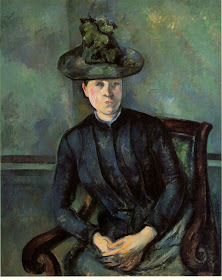

(Thanks www.dl.ket.org)


(Thanks www.dl.ket.org)
In other words, things appear to us as dynamically deformed. Just moving a little bit will change how the things in a scene before us appear. But that is how we look at things, by moving our eyes around it. But our mind is able to synthesize all the differences together into a perception of something more organized and seemingly stable. This is what a photograph presents to us, the finished product. But Cézanne's paintings give us the experience of seeing the actual things. He knows that even though they might look deformed when compared to a realistic rendition, they will appear natural. They will appear as if we had Cézanne's eyes while he was in the act of seeing the objects.
So all the different ways the object appears are synthesized coherently and holistically so that we properly perceive their visual features. But also, all our senses are together involved in the sensation. They begin already as integrated.
Cezanne does not try to use color to suggest the tactile sensations which would give shape and depth. These distinctions between touch and sight are unknown in primordial perception. It is only as a result of a science of the human body that we finally learn to distinguish between our senses. The lived object is not rediscovered or constructed on the basis of the contributions of the senses; rather, it presents itself to us from the start as the center from which these contributions radiate. We see the depth, the smoothness, softness, the hardness of objects; Cezanne even claimed that we see the odor. If the painter is to express the world, the arrangement of his colors must bear within this indivisible whole, or else his painting will only hint at things and will not give them in the imperious unity, the presence, insurpassable plenitude which is for us the definition of the real. (5a, see 15c, boldface mine)Cézanne came before an indeterminate scene where its parts are given together, but in a way that allows us to ignore certain aspects in favor of others. So Cézanne tried to present these aspects as interwoven together. Cézanne called this phenomenally rich scene he painted his motif (we discuss Deleuze's interpretation of Cézanne's motif here.) The painter's job is to produce a recognizable image by means of the synthesis of the scene's parts.
He went to the Louvre every day when he was in Paris. He believed that one must learn how to paint and that the geometric study of planes and forms is a necessary part of this learning process. He inquired about the geological structure of his landscapes, convinced that these abstract relationships, expressed, however, in terms of the visible world, should affect the act of painting. The rules of anatomy and design are present in each stroke of his brush just as the rules of the game underlie each stroke of a tennis match. But what motivates the painter's movement can never be simply perspective or geometry or the laws governing the breakdown of color, or, for that matter, any particular knowledge. Motivating all the movements from which a picture gradually emerges there can be only one thing: the landscape in its totality and in its absolute fullness, precisely what Cezanne called a "motif." He would start by discovering the geological foundations of the landscape; then, according to Mme Cezanne, he would halt and look at everything with widened eyes, "germinating" with the countryside. The task before him was, first, to forget all he had ever learned from science and, second, through these sciences to recapture the structure of the landscape as an emerging organism. To do this, all the partial views one catches sight of must be welded together; all that the eye's versatility disperses must be reunited; one must, as Gasquet put it, "join the wandering hands of nature." "A minute of the world is going by which must be painted in its full reality." His meditation would suddenly be consummated: "I have a hold on my motif," Cezanne would say, and he would explain that the landscape had to be tackled neither too high nor too low, caught alive in a net which would let nothing escape. Then he began to paint all parts of the painting at the same time, using patches of color to surround his original charcoal sketch of the geological skeleton. The picture took on fullness and density; it grew in structure and balance; it came to maturity all at once. "The landscape thinks itself in me," he would say, "and I am its consciousness." Nothing could be farther from naturalism than this intuitive science. Art is not imitation, nor is it something manufactured according to the wishes of instinct or good taste. It is a process of expression. Just as the function of words is to name—that is, to grasp the nature of what appears to us in a confused way and to place it before us as a recognizable object—so it is up to the painter, said Gasquet, to "objectify," "project," and "arrest." [...]Cézanne as a painter is sensitive to the way we are visually affected by the world, and his job is not so much to paint the world as much as it is to paint our relation with the world, the way it affects us.
We, forgetting the viscous, equivocal appearances, go through them straight to the things they present. The painter recaptures and converts | into visible objects what would, without him, remain walled up in the separate life of each consciousness: the vibration of appearances which is the cradle of things. (6a.c, see 17a.17d; 17-18)
Cezanne's difficulties are those of the first word. He thought himself powerless because he was not omnipotent, because he was not God and wanted nevertheless to portray the world, to change it completely into a spectacle, to make visible how the world touches us. (7d, see 19d)Consider when we see a new painting that really impresses us. We need look at it in a way we have never looked at something before. It teaches us a new way to see the world. And we learn this new way of seeing through the process of our novel encounter with the work. It somehow simultaneously teaches how to 'read a new text' if you will, by means of the new language of that text which we still need to learn.
It is not enough for a painter like Cezanne, an artist, or a philosopher, to create and express an idea; they must also awaken the experiences which will make their idea take root in the consciousness of others. If a work is successful, it has the strange power of being self-teaching. The reader or spectator, by following the clues of the book or painting, by establishing the concurring points of internal evidence and being brought up short when straying | too far to the left or right, guided by the con-fused clarity of style, will in the end find what was intended to be communicated. The painter can do no more than construct an image; he must wait for this image to come to life for other people. When it does, the work of art will have united these separate lives; it will no longer exist in only one of them like a stubborn dream or a persistent delirium, nor will it exist only in space as a colored piece of canvas. It will dwell undivided in several minds, with a claim on every possible mind like a perennial acquisition. (8a, see 19d)
Merleau-Ponty. "The Eye and Mind." Transl. Carleton Dallery. in The Primacy of Perception and other Essays on Phenomenological Psychology, the Philosophy of Art, History, and Politics. Ed. James M. Edie. Evanston: Northwestern University Press, 1964.
Quotations come from the PDF, obtained very gratefully from Timothy Quigley's course page
http://homepage.newschool.edu/%7Equigleyt/vcs/em-text.pdf
Merleau-Ponty. "Cézanne's Doubt." Transl. Hubert L. Dryfus & Patricia Allen Dreyfus. In Sense and Non-Sense. Chicago: Illinois University Press, 1964.
Quotations from the PDF also obtained with all my gratitude from Robert Innis' course page:
http://faculty.uml.edu/rinnis/cezannedoubt.pdf
Quotations come from the PDF, obtained very gratefully from Timothy Quigley's course page
http://homepage.newschool.edu/%7Equigleyt/vcs/em-text.pdf
Merleau-Ponty. "Cézanne's Doubt." Transl. Hubert L. Dryfus & Patricia Allen Dreyfus. In Sense and Non-Sense. Chicago: Illinois University Press, 1964.
Quotations from the PDF also obtained with all my gratitude from Robert Innis' course page:
http://faculty.uml.edu/rinnis/cezannedoubt.pdf
Images
Cézanne: Gustave Geoffrey
http://en.easyart.com/canvas-prints/Paul-Cezanne/Gustave-Geffroy-354053.htm
Cézanne: Still Life with Apples (1890-94)
http://www.dl.ket.org/webmuseum/wm/paint/auth/cezanne/sl/apples/index.htm
Cézanne. Still Life, Fruit and Pitcher on Table
http://www.awesome-art.com/awesome/shop/category.aspx?catid=44&page=1&sortby=
(Thanks awesome-art.com)
Cézanne: Portrait of a Woman in Green Hat (Mme Cézanne) (1894-95)
http://www.dl.ket.org/webmuseum/wm/paint/auth/cezanne/portraits/mme/index.htm
Rembrandt's Nightwatch
http://www.russianpaintings.net/doc.vphp?id=753

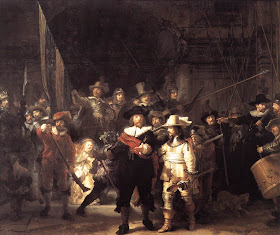
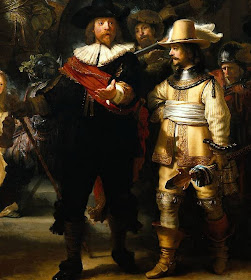
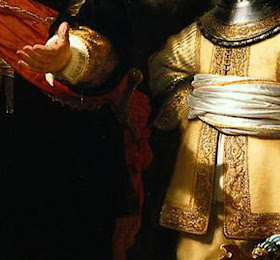
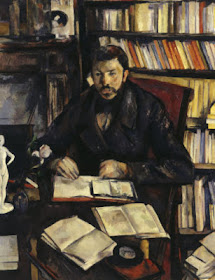
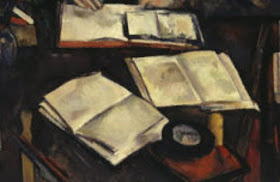
No comments:
Post a Comment